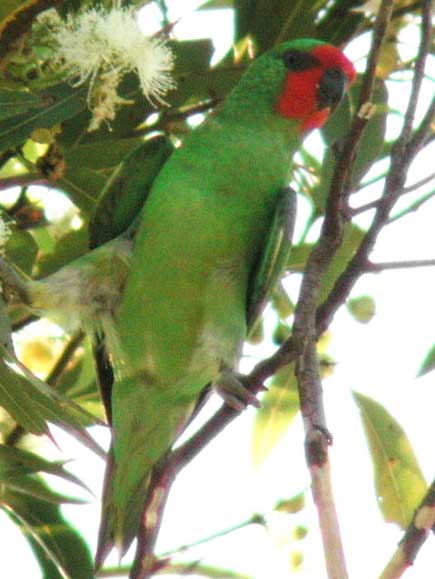
Glossopsitta pusilla (*)
Superregnum: Eukaryota
Cladus: Unikonta
Cladus: Opisthokonta
Cladus: Holozoa
Regnum: Animalia
Subregnum: Eumetazoa
Cladus: Bilateria
Cladus: Nephrozoa
Superphylum: Deuterostomia
Phylum: Chordata
Subphylum: Vertebrata
Infraphylum: Gnathostomata
Megaclassis: Osteichthyes
Cladus: Sarcopterygii
Cladus: Rhipidistia
Cladus: Tetrapodomorpha
Cladus: Eotetrapodiformes
Cladus: Elpistostegalia
Superclassis: Tetrapoda
Cladus: Reptiliomorpha
Cladus: Amniota
Classis: Reptilia
Cladus: Eureptilia
Cladus: Romeriida
Subclassis: Diapsida
Cladus: Sauria
Infraclassis: Archosauromorpha
Cladus: Crurotarsi
Divisio: Archosauria
Cladus: Avemetatarsalia
Cladus: Ornithodira
Subtaxon: Dinosauromorpha
Cladus: Dinosauriformes
Cladus: Dracohors
Cladus: Dinosauria
Ordo: Saurischia
Cladus: Eusaurischia
Subordo: Theropoda
Cladus: Neotheropoda
Cladus: Averostra
Cladus: Tetanurae
Cladus: Avetheropoda
Cladus: Coelurosauria
Cladus: Tyrannoraptora
Cladus: Maniraptoromorpha
Cladus: Maniraptoriformes
Cladus: Maniraptora
Cladus: Pennaraptora
Cladus: Paraves
Cladus: Eumaniraptora
Cladus: Avialae
Infraclassis: Aves
Cladus: Euavialae
Cladus: Avebrevicauda
Cladus: Pygostylia
Cladus: Ornithothoraces
Cladus: Ornithuromorpha
Cladus: Carinatae
Parvclassis: Neornithes
Cohors: Neognathae
Cladus: Neoaves
Cladus: Telluraves
Cladus: Australaves
Ordo: Psittaciformes
Familia: Psittaculidae
Subfamilia: Loriinae
Genus: Glossopsitta
Species: Glossopsitta pusilla
Name
Glossopsitta pusilla (Shaw, 1790)
References
J.voy.NewS.Wales[White] p.262 pl.48
Vernacular names
English: Little Lorikeet
español: Lori carirrojo
suomi: Pikkulurikki
français: Lori à Masque Rouge
magyar: Kis Mósuszlóri
русский: Крошечный мускусный лорикет
The little lorikeet (Parvipsitta pusilla) is a species of parrot in the family Psittaculidae. It is endemic to Australia. It is a small parrot, predominantly green in plumage with a red face. Its natural habitats are subtropical or tropical dry forest and subtropical or tropical moist lowland forest.
Taxonomy
The little lorikeet was first described by ornithologist George Shaw in 1790 as Psittacus pusillus. Its specific epithet is the Latin pusilla "small".[2] Other common names include tiny lorikeet, red-faced lorikeet,[3]: 119 gizzie, slit,[4]: 31 and formerly a local indigenous term gerryang.[5]
Description
Measuring 15 cm (5.9 in) in length, the male and female are similarly coloured, although the latter is a little duller. The crown, lores and throat are red, the nape and shoulder bronze-coloured and the remainder of the plumage green. The belly is paler and yellow-green. In adults, the bill is black and the iris golden in colour.[3]: 119 Immature individuals have a paler orange face and a brown iris and bill.[6]
Distribution and habitat
The little lorikeet is found in eastern and southern Australia, from the vicinity of Cairns southwards through Queensland and New South Wales from the western slopes of the Great Dividing Range eastwards to the coast, through most of Victoria and southeastern South Australia. It also occurs in Tasmania although is uncommon there.[4]: 31–32 [6] They are found in forest, especially in the vicinity of flowering or fruit-bearing vegetation.[7]: 90
Behaviour
The little lorikeet is gregarious and often flocks with rainbow, musk and purple-crowned lorikeets.[8]
Feeding
Little lorikeets feed mostly on nectar and pollen of flowers in the open canopy of woodland trees like Eucalyptus, Angophora and Melaleuca species.[9] They have also been known to feed on native grasstrees (Xanthorrhoea spp.), and occasionally on fruit like the native mistletoe and introduced loquat (Eriobotrya japonica). They will occasionally visit orchards.[7]
Breeding
Breeding season is from May in the north, or August in the south, to December. The nest is a hollow in a tree and a clutch of 3–5 matte white roundish eggs, measuring 20 x 16 mm, is laid. The incubation period is around three weeks.[7]
Aviculture
Although first exported to Europe in 1877, the little lorikeet is only very rarely seen outside Australia. Even in its native country, it is uncommon in captivity.[3]: 120–121 It has a reputation of being difficult to keep.[4]: 33
0:43
Pair, Pikedale, S. Queensland
References
BirdLife International (2012). "Glossopsitta pusilla". IUCN Red List of Threatened Species. 2012. Retrieved 26 November 2013.
Simpson DP (1979). Cassell's Latin Dictionary (5th ed.). London: Cassell Ltd. p. 883. ISBN 0-304-52257-0.
Low, Rosemary (1978). Lories and Lorikeets. Melbourne: Inkata Press. ISBN 0-909605-08-4.
Lendon, Alan H. (1973). Australian Parrots in Field and Aviary (2nd ed.). Sydney: Angus and Robertson. ISBN 0-207-12424-8.
Long, George (1841). The Penny Cyclopædia of the Society for the Diffusion of Useful Knowledge. London: Charles Knight & Co. p. 90.
Morcombe, Michael (2000). Field Guide to Australian Birds. Archerfield, Queensland: Steve Parish Publishing. pp. 174–175. ISBN 187628210X.
Forshaw, Joseph M. & Cooper, William T. (1978). Parrots of the World (2nd ed.). Melbourne: Landsdowne Editions. ISBN 0-7018-0690-7.
"Little Lorikeet". BirdLife Australia. Retrieved 17 April 2019.
"Little Lorikeet - profile". New South Wales Government Office of Environment and Heritage. Retrieved 17 April 2019.
Retrieved from "http://en.wikipedia.org/"
All text is available under the terms of the GNU Free Documentation License

